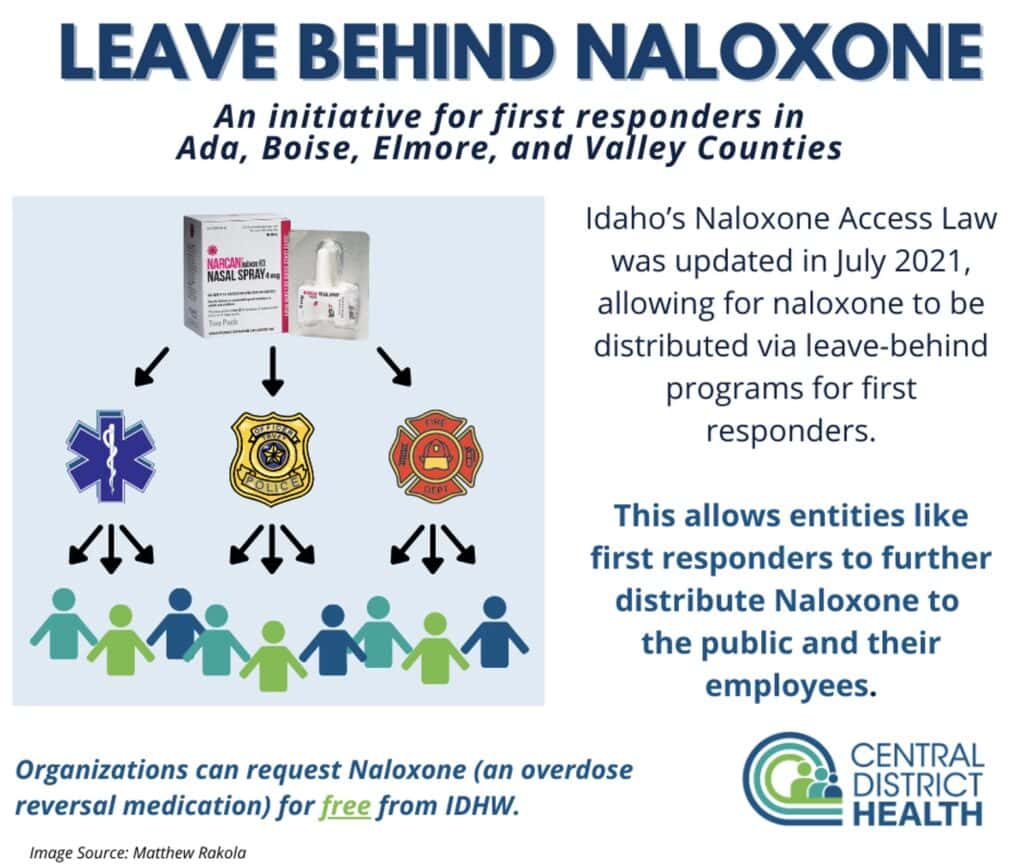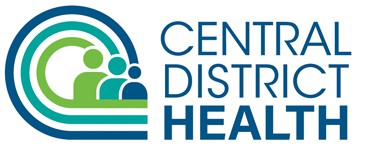NALOXONE LEAVE-BEHIND RESOURCES
Home > Health > Prevention Programs > Drug Overdose Prevention Program > Naloxone Leave-Behind Resources
Naloxone (Narcan) is a medication that can reverse an overdose caused by opioids, including prescription pain medication, fentanyl or heroin. When administered during an overdose, naloxone blocks the effects of opioids on the brain and restores breathing.
The duration of the naloxone’s effect varies, but typically lasts between 30 and 60 minutes. After opioid receptors are no longer blocked by naloxone, the individual may resume overdosing. Depending on the situation, it may be necessary to administer naloxone multiple times. It is important to call 911, even if it appears the individual is no longer overdosing.

FAQS
In Idaho, anyone can ask for a prescription for naloxone from a physician, physician’s assistant, nurse practitioner or pharmacist. In a medical emergency like an overdose, individuals cannot administer naloxone to themselves. Naloxone does not need to be for your own use, which means members of the community, family members, friends, first responders, and bystanders can receive naloxone and administer or “leave-behind” naloxone to anyone else. Someone who administers naloxone to a person who appears to be experiencing an opioid overdose is legally protected by Idaho’s Naloxone Access Law and Idaho’s Good Samaritan Law. Idaho’s Naloxone Access Law was updated in July 2021, allowing for naloxone to be distributed via leave-behind programs for first responders. This bill permits entities, such as first responder organizations, to further distribute naloxone to the public and their employees.
Source: Network for Public Health Law (August 2020). Harm Reduction Laws in Idaho.
The aim of this program is to improve the safety and health outcomes for individuals that have experienced an overdose or are at risk for an overdose. Providing naloxone can save a life and serves as a tool to begin a risk reduction conversation on accessing care, services, and treatment.
Idaho’s Naloxone Access Law allows public safety providers who have responded to an individual experiencing an opioid-related overdose, or someone they believe to be at risk of an overdose, to leave behind naloxone. This law also covers bystanders of an overdose, or who may be at risk for an overdose, to receive naloxone.
Public safety providers should provide brief instructions on how to recognize and respond to an overdose, including the administration of naloxone and calling 911.
Individuals
• Narcan can be ordered for free through CDH’s Drug Overdose Prevention Program. To order visit cdhhealthcare.com
• Anyone with Idaho Medicaid can get naloxone for free at the pharmacy. Family or friends may request naloxone for someone with Medicaid using their Medicaid ID number and name.
• Anyone can use their personal or private insurance to request naloxone from a pharmacist. Some insurances require a pre-authorization for over-the-counter medications. For a list of pharmacies in your area, visit DHW’s service and resource list.
• Narcan (4mg intranasal naloxone) is available over-the-counter at many retail stores, including Walmart.
Organizations
• The Idaho Department of Health and Welfare (DHW) coordinates naloxone distribution to organizations in Idaho. DHW’s naloxone request form can be found at https://app.keysurvey.com/f/41689119/17ac/.
- Probation and parole officers;
- Law enforcement agencies (including municipal police, sheriff’s offices, campus police, campus security, school resource officers, and park rangers);
- Firefighters (including both volunteer and paid firefighters);
- Emergency medical services, advanced life support, basic life support, and emergency medical technicians;
- Other first responder organizations serving individuals and communities impacted by substance use that are organized and trained to respond to overdose emergencies and administer intranasal naloxone;
- Organizations that provide services and supports to people who use drugs (PWUD) including people who inject drugs (PWID);
- Individuals with substance use disorder (SUD) and/or opioid use disorder (OUD) leaving correctional facilities;
- Individuals with SUD/OUD currently engaged in treatment and/or in recovery; and/or
- Individuals receiving care in emergency departments for an overdose.
Although not necessary in order to obtain the medication, it is recommended that organizations and individuals receive training to recognize the signs and symptoms of an overdose and to learn how to properly administer naloxone.
CONTACT
Can’t find the information you need? Please complete the form or give us a call.

